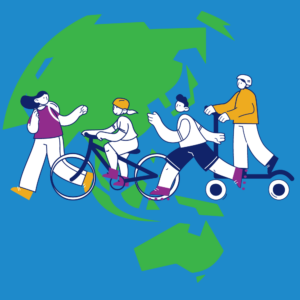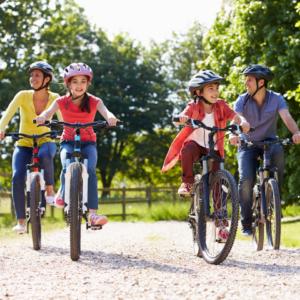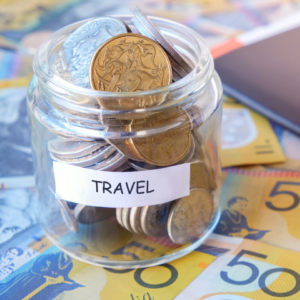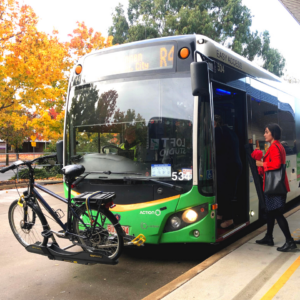
Making the move to clean transport benefits you and the planet
Improve your and your family’s health by getting active

Natural high
Being active outdoors increases endorphins and boosts your mood, leading to better mental health, focus and sharpness of mind, and reduced stress, depression and anxiety. Spend more time moving and arrive feeling energised instead of frustrated by traffic.
Quality time
Walking or cycling with your children to their school creates conversation time to hear all about their day, their friends, their worries and adventures. Healthy habits and social relationships in childhood set children up well for life.
Health for life
Walking or cycling for 30 minutes a day can lower the risk of chronic diseases including heart disease, stroke, diabetes, high blood pressure and some cancers. Cycle commuters are less likely to be overweight or obese and have a substantially lower mortality rate than drivers.
Sleep soundly
Just 30 minutes of moderate aerobic exercise helps you get to sleep more quickly and deeply. Rhythmic pedaling regulates serotonin, clears the mind and aids brain function, while being outside in daylight resets circadian rhythm and melatonin production for your body to clock a better night’s sleep.
Experience the bush capital
Cycling and walking gets us away from digital devices and into nature, under trees, over waterways, past gardens, looking for birds and creatures, smelling the earth, feeling the weather on our skin, and deepens our connection to the land that we live in.
Solo strength
The satisfaction of moving under your own steam builds confidence, independence, decision-making and spatial skills that carry through into other aspects of your life, especially for kids and seniors.
Bonds of fun
Cycling with your partner, children or friends builds bonds of friendship and shared fun times. Feel the childlike freedom of whizzing down a hill with the wind in your hair. Chat with other people you meet and make new friends.
Mighty muscles & bones
Weight-bearing exercise like walking maintains bone density, reducing risk of osteoporosis. Cycling activates, strengthens and tones all major muscle groups, improving balance and coordination while minimising impact on joints.
Health check
Visit your doctor for a general health check and advice before getting active if in doubt about your fitness or if you have existing health conditions or risk factors. Often, exercise is the best medicine!
Save thousands of dollars by swapping car trips for active travel
Did you know that an average two-car household spends almost $17,000 per year on car ownership? (Budget Direct)
It’s easy to buy the dream of car ownership without ever considering the full financial cost for yourself or your family or the impacts on society and the environment. Yet, pretty much everything that you do in your car can be done as effectively and definitely more cheaply by getting active!

Leaving a car at home can save you hundreds of dollars per year on parking and fuel. The savings in the first year or two would pay for a couple of pushbikes and MyWay public transport cards, plus an occasional taxi or ride-share.
Reducing from two (or more!) cars to just one will save your family thousands of dollars a year on loan repayments, registration, insurance and maintenance costs. The proceeds from selling a car would easily pay for an electric bike or two, plus hire cars when you really need them.
Because we don’t fork out cash every time we get in the car, we tend not to think about the big annual costs, but the average driver is paying about $17.80 per car trip. You would think twice about hopping in the car if you had to pay that on the spot every time!
In addition to eliminating the direct costs of owning a car, becoming more active will improve your health which in turn reduces medical costs. Consider also how much time a car owner spends working to earn the money to pay for their car – time or earnings that could be devoted to other more enjoyable activities.
Free yourself from the burden of car ownership!
The costs below are estimates* for one small-to-medium passenger car, commuting 9km** each way, 5 days per week for 46 weeks, or 460 trips and 4140km per year. The fixed costs add up to $6180 per year. Assuming that you use your car about another 30% for other trips on weekends, evenings and holidays, the annual cost of running one car is about $10,629.
*For a more accurate figure, pull out your own paperwork for each of the items below, or visit RACQ or RACV or the Australian Government’s MoneySmart Cars app. **Length of average car trip (ACT Transport Strategy 2020).
Fuel
The best fuel-saving tip is don’t drive! For a car using 9 litres/100km, at the current fuel price of around $1.35/litre, fueling your car for commuting costs around $503 per year. A small electric car will cost around $98 per year to charge for the same distance.
Parking
All-day parking in town centres generally costs $10–20 per day. At an average of $15 per day, that will cost $3450 per year. Add to that the time you waste driving round the block looking for a spot. Cycling gives you door-to-door convenience!
Registration and licence fees
Registration in the ACT includes Compulsory Third Party insurance, levies and registration, averaging at around $1140 per year. (For a limited time) Electric cars are eligible for 2 years of free registration but other costs will still apply. A five-year driver’s licence costs about $185.
Insurance and maintenance
Comprehensive car insurance costs around $650 per year. Roadside assistance costs about $110 per year. Servicing costs around $750 per year plus around $600 every 5 years for a set of new tyres.
Purchase and depreciation
Australian families spend on average $30,000 when buying a new car. By the end of the first year of owning it, it is worth 30% less, while you spend the next ten years paying off the bank loan plus interest, at an average of $65 per week, or $3380 per year.
Garage space
The average car is stationary 96% of the time and about 80% of that time is in the garage/carport/yard. A single enclosed garage costs about $30–40,000 to build. With one less car, that space could be freed up to become a workshop, studio, teenage hangout, spa room, granny flat, entertaining area, veggie garden or whatever you like!
Help the planet by travelling green
95% of Canberra households own at least one vehicle and 57% of households own two or more. With over 290,000 passenger and light commercial vehicles and a population of 340,000 people aged 16 years or more, that’s 5 cars for every 6 adults of driving age in the ACT. Every day, Canberrans make one million car trips and 35% of our travel is to work or school.
Car travel has a massive impact that reaches well past our own driveways. Reducing the number of trips, increasing the number of passengers per low-emissions vehicle, and making the move into active and public transport are effective actions we can take to reduce our ecological footprint (another is to make the switch from gas to electricity in your home!).
Fewer cars on the road means less congestion and pollution, and frees up parking space for better uses like recreation parks. It makes more space on roads for essential vehicle use, saves on the cost of building and maintaining more roads. Getting cars off the road makes streets safer for cycling, walking and playing – the fun stuff!

Don’t be the traffic
Congestion isn’t caused by a lack of roads and carparks – the problem is an abundance of cars. We can’t solve congestion by building more lanes, overpasses, traffic management systems or multi-story parking centres – all of those fixes simply attract more cars. The real solution is fewer cars and better public transport services and active travel infrastructure, which then opens up city streets for cycling, walking, trees, community spaces and more pleasant street frontages. A full bus can take 40 cars off the road. Remember, when you’re sitting in traffic, you ARE the traffic!
Cut carbon emissions
Cars produce around a fifth of global greenhouse gas emissions, from driving (direct emissions) and their manufacture (embodied emissions). For every kilometre you actively travel instead of driving a petrol car, you save around 330 grams of carbon emissions. As a full-time commuter with a 9km trip each way, 5 days per week for 46 weeks per year, you could save over 1300kg of carbon emissions each year by switching out your car! There are also environmental impacts from all the metals, plastics, glass, rubber and other materials required to build and transport millions of new cars each year.
Smog off
The exhaust from petrol-, diesel- and gas-fueled vehicles variously contains carbon dioxide, carbon monoxide, nitrogen oxides, sulphur oxides, methane, benzene, volatile organic compounds and particulates. All of these are either greenhouse gases that cause climate change or form smog that damages human health, dirties buildings and coats plant leaves, restricting photosynthesis. Some are both. That “new car smell” is the off-gassing of carcinogenic formaldehyde and benzene from the interior plastics, chromium from leather which causes infertility, and bromide from fire retardant, known to affect brain and thyroid function.
Safer streets
In Australia, more than 20 people are killed in road accidents every week. Over the past 10 years, on average more than 200 pedestrians and cyclists are killed by motor vehicles each year, well over half of those in speed zones 60km/h and below. Add to that some 40,000 people each year who are seriously injured, including over 9000 pedestrians and cyclists. If 20 people died in cinemas each week, there would be uproar. Cars are powerful tools in our modern lives, but they are also deadly machines that take and ruin lives. Fewer car trips would make our streets safer for everyone.
Better uses of land and funds
About a third of urban space in Canberra is devoted to cars – roads, parking lots, private garages. The more Canberrans who get out of their cars and onto bike paths and buses, the greater the justification for redirecting public funds from building roads and carparks to improving public and active transport services and city amenities that contribute to wellbeing, including pedestrian zones and public green spaces. Convert a home’s car space to more creative uses – a studio, student accommodation or a veggie garden, for instance. Let’s stop paving paradise to put up parking lots!
Consume less
The average car, whether petrol or electric, is made from around 1.5 tonnes of different materials including metals, plastics, rubbers, chemicals and textiles, all of which have impacts on the environment and human health when they are mined, manufactured, transported, marketed and driven, and when the car is scrapped. Building a bike or a bus uses a fraction of the materials and energy per person.
